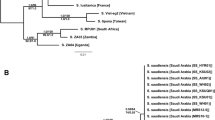Abstract
Combining molecular and morphological evidence, an invasive ant in Missouri and Illinois, USA, is identified as Tetramorium tsushimae Emery, 1925, a polygynous-polycalic species native to East Asia. T. tsushimae is recorded as invasive for the first time. RFLP and worker morphometrics provide tools for reliable determination. Mitochondrial DNA data reveal the probable geographic origin of the invasive populations to be Japan.
Similar content being viewed by others
References
RH Crozier YC Crozier (1993) ArticleTitleThe mitochondrial genome of the honeybee Apis mellifera: complete sequence and genome organization Genetics. 133 97–117 Occurrence Handle8417993 Occurrence Handle1:CAS:528:DyaK3sXisVyrtrc%3D
R. DeSalle T Freedman EM Prager AC Wilson (1987) ArticleTitleTempo and mode of sequence evolution in mitochondrial DNA of Hawaiian Drosophila. Journal of Molecular Evolution. 26 157–164 Occurrence Handle3125333 Occurrence Handle10.1007/BF02111289 Occurrence Handle1:CAS:528:DyaL1cXhslWmtw%3D%3D
O Folmer M Black W Hoeh R Lutz R Vrijenhoek (1994) ArticleTitleDNA primers for amplification of mitochondrial cytochrome c oxidase subunit I from diverse metazoan invertebrates Molecular Marine Biology and Biotechnology. 3 IssueID5 294–299 Occurrence Handle7881515 Occurrence Handle1:CAS:528:DyaK2MXjt12gtLs%3D
DA Holway L Lach AV Suarez ND Tsutsui TJ Case (2002) ArticleTitleThe causes and consequences of ant invasions Annual Review of Ecology and Systematics. 33 181–233 Occurrence Handle10.1146/annurev.ecolsys.33.010802.150444
Japanese Ant Database Group (2003) Tetramorium tsushimae. Retrieved from http://ant.edb.miyakyo-u.ac.jp/E/Taxo/F40902.html on 15 April 2004
PD Krushelnycky LL Loope SM Joe (2004) ArticleTitleLimiting spread of a unicolonial invasive insect and characterization of seasonal patterns of range expansion Biological Invasions. 6 47–57 Occurrence Handle10.1023/B:BINV.0000010121.45225.cc
TP McGlynn (1999) ArticleTitleThe worldwide transfer of ants: geographical distribution and ecological invasions Journal of Biogeography. 26 535–548 Occurrence Handle10.1046/j.1365-2699.1999.00310.x
McGlynn TP (2002) Non-native Ants. Retrieved from http://home.sandiego.edu/~tmcglynn/exotic.htm on 15 April 2004
DJ O’Dowd PT Green PS Lake (2003) ArticleTitleInvasional ‘meltdown’ on an oceanic island Ecology Letters. 6 812–817
BC Schlick-Steiner FM Steiner S Schödl (2003) ArticleTitleA case study to quantify the value of voucher specimens for invertebrate conservation: Ant records in Lower Austria Biodiversity and Conservation. 12 2321–2328 Occurrence Handle10.1023/A:1024592408749
C Simon F Frati A Beckenbach B Crespi H Liu P Flook (1994) ArticleTitleEvolution, weighting, and phylogenetic utility of mitochondrial gene sequences and a compilation of conserved polymerase chain reaction primers Annals of the Entomological Society of America. 87 651–701 Occurrence Handle1:CAS:528:DyaK2MXis1Wiu7g%3D
FM Steiner BC Schlick-Steiner A Nikiforov R Kalb R Mistrik (2002) ArticleTitleCuticular hydrocarbons of Tetramorium ants from Central Europe: analysis of GC-MS data with Self-Organizing Maps (SOM) and implications for systematics Journal of Chemical Ecology. 28 2569–2584 Occurrence Handle12564801 Occurrence Handle10.1023/A:1021496305308 Occurrence Handle1:CAS:528:DC%2BD38XpsValsbo%3D
Swofford DL (1998) PAUP*: Phylogenetic Analysis using Parsimony (*and other methods). Version 4.0b3. Sunderland, MA, Sinauer
K Tamura M Nei (1993) ArticleTitleEstimation of the number of nucleotide substitutions in the control region of mitochondrial DNA in humans and chimpanzees Molecular Biology and Evolution. 10 512–526 Occurrence Handle8336541 Occurrence Handle1:CAS:528:DyaK3sXks1CksL4%3D
JD Thompson TJ Gibson F Plewniak F Jeanmougin DG Higgins (1997) ArticleTitleThe Clustal-X windows interface: flexible strategies for multiple sequence alignment aided by quality analysis tools Nucleic Acids Research. 25 4876–4882 Occurrence Handle9396791 Occurrence Handle10.1093/nar/25.24.4876 Occurrence Handle1:CAS:528:DyaK1cXntFyntQ%3D%3D
Author information
Authors and Affiliations
Corresponding author
Additional information
The first two authors contributed equally to this work.
Rights and permissions
About this article
Cite this article
Steiner, F.M., Schlick-Steiner, B.C., Trager, J.C. et al. Tetramorium tsushimae, a New Invasive Ant in North America. Biol Invasions 8, 117–123 (2006). https://doi.org/10.1007/s10530-004-1249-7
Received:
Accepted:
Issue Date:
DOI: https://doi.org/10.1007/s10530-004-1249-7




